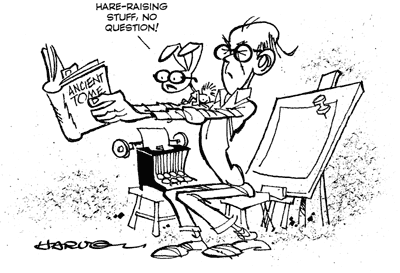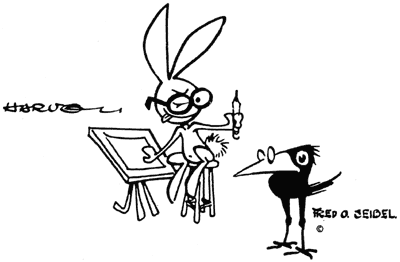
The Whole Sordid Story
Harvey has had no formal training in cartooning and very little (as you
might deduce) in writing other than actual experience on the campus newspaper
at the University of Colorado, from which he graduated in 1959.
He says he’s
been drawing cartoon characters since the age of seven, when he started
copying pictures in comic books. “After about ten years,” he said, “I’d
copied so many different cartoonists and borrowed such a variety of styles
that no one could tell who I was copying any more. I had arrived.”
Harvey’s first
encounter with magazine cartooning was in college where he drew cartoons
for the campus humor magazine, The Flatiron. It was here that
he first used a tiny drawing of a spectacled rabbit (“Harvey the Rabbit,”
shades of Mary Chase) as his signature. (For the Exhaustive Discussion
of the Rabbit, click here.)
After college,
Harvey freelanced at cartooning in New York City for a time, then went
into the Navy, where he eventually spent over $9 million as paymaster
aboard the famed USS Saratoga (CVA 60). Although he enjoyed cruising
around the blue Mediterranean, his interest in things nautical was, at
best, merely fleeting. Upon discharge after three years, Harv turned
to teaching.
“I taught
high school English for several years,” Harvey reported, “but I had to
give it up when I discovered that I wasn’t supporting myself at it. It
was just as well: Being an English teacher is somewhat like being a carrier
of the plague. As soon as my occupation became known in mixed company,
whatever throngs were within earshot would immediately clam up and begin
looking nervously over their shoulders for split infinitives, dangling
participles, off-color adjectives, and similar kinds of disorderly grammatical
conduct (all of which, I should say, are entirely permissible between
consenting adults.)
“It’s demoralizing
to be thought of as the watchdog of everyone else’s language,” Harvey
continued. “Not only that, it’s lonely. So in an attempt to demonstrate
that I was just one of the fellas on the corner (like everyone else),
I began to draw cartoons about sexy girls--some of them in broken English,
some of them in nothing at all.”
This effort,
as might be expected, did not produce a living wage. For that, Harvey
found work as an advance man for a school teachers’ road show (that is,
as convention manager for a teachers’ association). He persisted in this
thankless task for nearly thirty years before giving it all up for the
blissful state of retirement, where he now resides.
In addition
to columns and articles for numerous comics-related publications, he authored
two theoretical and historical tomes about cartooning: The Art of
the Funnies (1994, an “aesthetic history” of the comic strip), The
Art of the Comic Book (1996), both from the University Press of Mississippi.
He also collected and edited two volumes of Cartoons of the Roaring
Twenties for Fantagraphics Books (1991 and 1992) and contributed biographies
of cartoonists to the American National Biography from Oxford University
Press. He was associate editor (for comic strip content) of the short-lived
scholarly journal, Inks: Cartoon and Comic Art Studies (1994-1997).
Harvey also
produced over 150 biographies for a collection of cartoonists’ self-caricatures,
A Gallery of Rogues: Cartoonists’ Self-caricatures, and wrote the
monograph The Genius of Winsor McCay (both from Ohio State University
Libraries, 1998). In addition, he was guest curator of an exhibition
of original comic strip art for the Frye Art Museum in Seattle (September-October
1998) and wrote the accompanying catalogue, Children of the Yellow
Kid (Frye Art Museum/Washington University, 1998). Subtitled “The
Evolution of the American Comic Strip,” the book examines the growth and
development of the medium through five distinct “movements” or modes.
Works in progress
include the definitive biography of Milton Caniff (creator of Terry
and the Pirates and Steve Canyon) and Accidental Ambassador
Gordo: The Comic Strip Art of Gus Arriola (due out in the summer of
2000), Conversations with Milton Caniff (summer 2001)--both from
the University Press of Mississippi--as well as a collection of the cartoons
of T.S. Sullivant. Harvey continues to produce a regular column in The
Comics Journal (a bi-monthly magazine) and an occasional column in
The Comics Buyer’s Guide (a weekly newspaper) as well as articles
on individual cartoonists whom he interviews for a quarterly magazine,
Cartoonist PROfiles.
The Rabbit
Or, A Real Hole Story
by R.C. Harvey
As reported previously, I concocted the rabbit dingbat while cartooning
in college. ("Dingbat" is the highly technical term used to
denominate small visual devices that cartoonists use in lieu of a verbal
signature.)
But I didn't
use the rabbit again for a long time after I escaped from college. I
didn't use it on any of my girlie cartoons because Playboy seemed
to have the franchise on rabbits, and I was pretty sure Hugh Hefner wouldn't
publish any of my cartoons if I signed them with a rabbit that would seem
to be imitating the magazine's mascot. And certainly no rival publication
would. (As it happened, Hefner never published any of my cartoons anyway,
rabbit or no.)
Finally, I
realized that women don't make passes at rabbits who wear glasses, so
the world seemed safe for my rabbit again.
But Pat Oliphant
stopped me. No, he didn't actually speak to me about it, but I was afraid
that people would think I was aping him with his diminutive penguin, Punk,
who adorns all his editorial cartoons. I didn't want to be perceived
as a rank copycat.
Then I got
peeved. Hey, I said (to myself), I was using a rabbit as a signature
as early as the fall of 1955, nearly a decade before Oliphant turned up
on these shores. So I decided not to let the Aussie-come-lately prevent
me from deploying my rabbit again. (He had stood in the way for over
twenty years as it was.)
Besides, editorial
cartoonists long before Oliphant used dingbats. My inspiration was Fred
O. Seibel, editorial cartoonist for the Richmond Times-Dispatch
for over three decades, who accompanied his signature with a bespectacled
crow--called "Jimmy Crow" at first, then, after racial sensitivity
set in, "Moses."
I call my
rabbit Cahoots. I call him that but that's not his name. He may not
have a name. Or his name might be Harvey. I chose the rabbit, as disclosed
earlier, because the name Harvey had become associated with a rabbit thanks
to Mary Chase's play, Harvey, the title of which was inspired by
one of the central figures of the production, a six-foot rabbit, usually
invisible, called "Harvey." My stratagem was that readers would
see the rabbit in my drawings and think--immediately, as a virtual knee-jerk
or Pavlovian drool--"Harvey!"
Clever, eh? Well, I'm only five-foot-eleven-inches
tall, but I have some rabbit habits.
Art of the Comic Book - Art of the Funnies - Accidental Ambassador Gordo - reviews - rants & raves - Harv's Hindsights - return to main page
